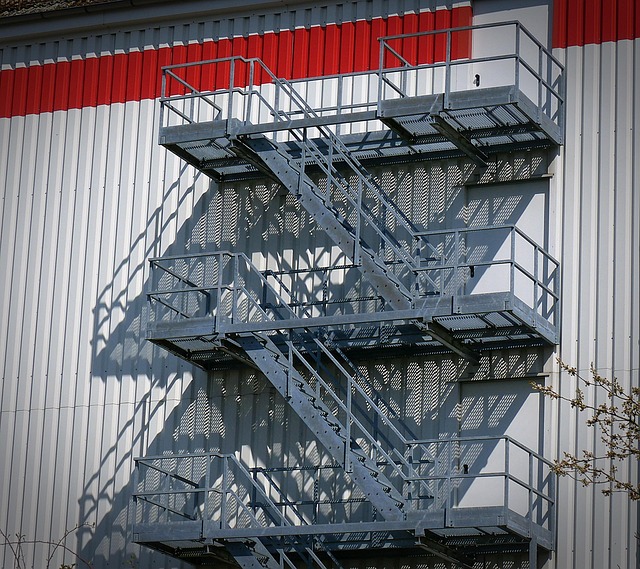Regular maintenance is vital for custom metal staircases to ensure their longevity, safety, and aesthetic appeal. This includes periodic inspections, cleaning with appropriate methods and products, addressing corrosion through protective coatings, prompt repair of damage or loose fasteners, and ongoing care such as lubrication and proper drainage. By implementing these strategic practices, you preserve the structural integrity and visual beauty of custom metal staircases, adhering to safety standards and preventing costly repairs.
Preserving the beauty and functionality of your custom metal staircases requires dedicated care. This article guides you through the essentials of maintaining and repairing iron or steel staircases, ensuring their longevity and safety. We explore the critical importance of regular maintenance, delve into key components for an effective plan, highlight common issues, and offer expert repair techniques. By implementing long-term preservation strategies, you’ll safeguard your custom metal staircases, preserving their aesthetic appeal and optimal performance.
Understanding the Importance of Regular Maintenance for Custom Metal Stairs
Custom metal staircases, with their intricate designs and durability, are a significant investment for any property. Regular maintenance is essential to preserve their aesthetic appeal, structural integrity, and safety over time. Neglecting routine care can lead to serious issues, from corroded components to unstable handrails.
Proper upkeep involves periodic inspections, cleaning, lubrication of moving parts, and prompt repair of any damage. These measures ensure the longevity of custom metal staircases, maintaining their initial beauty while adhering to safety standards. Regular maintenance also helps identify potential problems early on, preventing costly repairs or even accidents caused by structural failures.
Key Components to Consider in a Maintenance Plan
When developing a maintenance plan for your custom metal staircases, several key components require careful consideration to ensure longevity and optimal performance. Firstly, regular inspection is paramount. This involves meticulously assessing every aspect of the staircase, from the integrity of the metal structure to the condition of any moving parts or fittings. Regular inspections allow for early detection of potential issues, enabling prompt action to prevent minor problems from escalating into costly repairs.
Additionally, a comprehensive maintenance plan should include a detailed cleaning regimen tailored to your custom metal staircases. Corrosion and build-up can significantly impact both the aesthetic appeal and structural soundness of these structures. Choosing appropriate cleaning methods and products is essential to preserve the original finish while effectively removing dirt, grime, and other debris. This step ensures that your staircases not only look their best but also remain safe and functional for years to come.
Common Issues and Their Impact on Safety and Aesthetics
Custom metal staircases, while beautiful and durable, can face several issues over time that impact both safety and aesthetics. One common problem is rust, especially in environments with high moisture levels. Even a small amount of corrosion can weaken structural components, compromising the staircase’s integrity and posing potential safety hazards. The presence of rust also detracts from the overall aesthetic appeal of these intricate structures.
Another prevalent issue is loose or damaged fasteners, such as bolts and screws, which can occur due to normal wear and tear, exposure to extreme temperatures, or improper installation. This not only affects the visual charm but also has serious safety implications. Fasteners that are not securely fastened can lead to components shifting or detaching unexpectedly, creating tripping hazards and even structural failures. Regular inspections and timely repairs are crucial to mitigate these risks and ensure your custom metal staircases remain both safe and visually stunning.
Essential Repair Techniques for Iron and Steel Staircases
Preserving the integrity of iron or steel staircases requires a combination of regular cleaning, inspection, and targeted repairs. When it comes to essential repair techniques for these structures, one must consider the unique challenges posed by metal. Corrosion, for instance, is a significant issue that can weaken the structural soundness of custom metal staircases over time. Regular application of protective coatings, such as zinc or epoxy paints, can prevent rust and extend the lifespan of the stairs.
Another critical repair technique involves addressing structural damage caused by wear and tear, impact, or environmental factors. This may include replacing corroded or broken components like balusters, handrails, or steps. Metal welding and fabrication skills are invaluable in this regard, allowing for precise repairs and customizations tailored to the specific needs of each staircase. Regular maintenance checks should also focus on tightening connections, lubricating moving parts, and ensuring proper drainage to mitigate water damage—all essential practices to maintain the beauty, safety, and performance of custom metal staircases over the long term.
Long-Term Preservation Strategies for Optimal Performance
To ensure the longevity and optimal performance of your custom metal staircases, implementing strategic long-term preservation methods is essential. Regular cleaning and inspection are fundamental steps in this process. Remove any debris or buildup on the staircase’s surface using mild cleaning agents suitable for metal to prevent corrosion and maintain its aesthetic appeal. Periodically inspect the structure for signs of wear, such as rust spots, loose connections, or damaged railings, addressing these issues promptly to avoid further deterioration.
Additionally, applying protective coatings like epoxy or polyurethane can significantly extend the lifespan of your custom metal staircases. These coatings create a barrier between the metal and potential environmental factors, safeguarding against moisture intrusion, UV radiation, and extreme temperatures that could lead to rusting and structural compromise. By combining these preservation strategies with routine maintenance checks, you’ll ensure your metal staircases remain safe, visually appealing, and reliable for many years to come.
Preserving your custom metal staircases through regular maintenance and timely repairs is key to ensuring their longevity, safety, and aesthetic appeal. By understanding the critical components of a maintenance plan, recognizing common issues early on, and employing effective repair techniques, you can significantly extend the life of these durable structures. With the right strategies in place, your iron or steel staircases will continue to serve as a stunning focal point, providing safe access for years to come.
